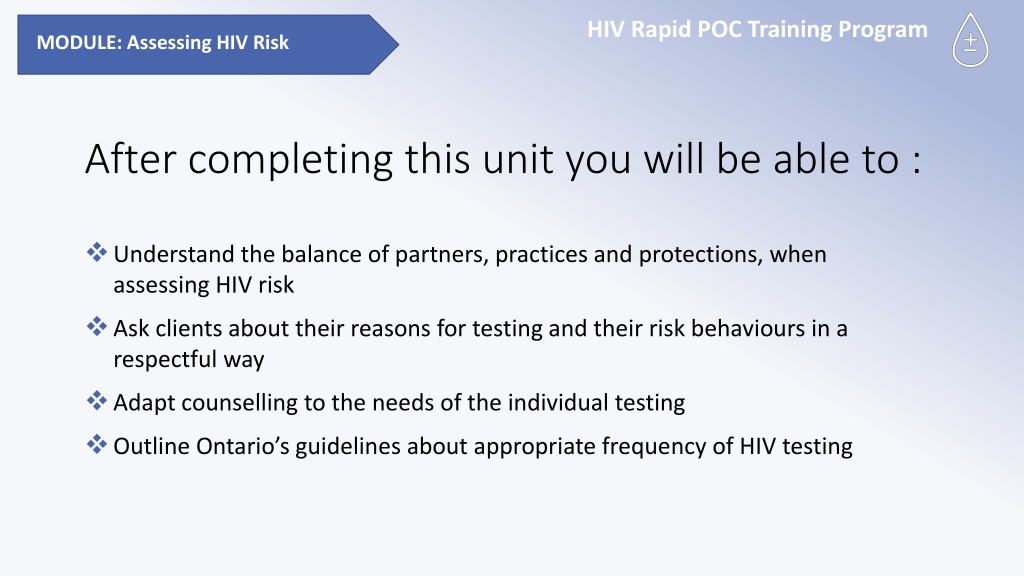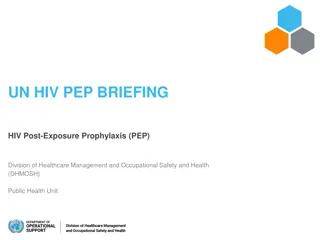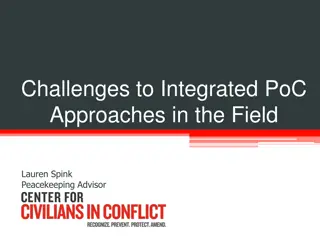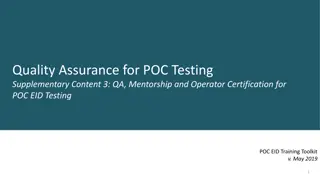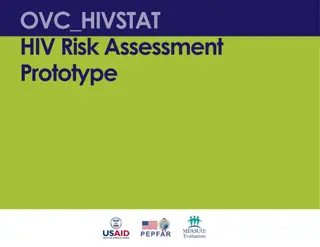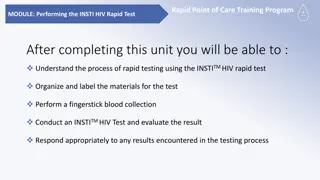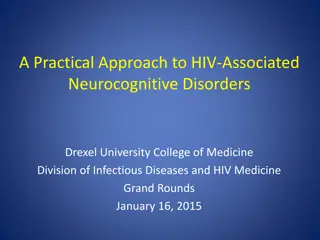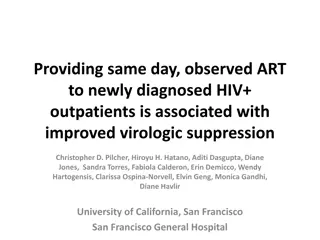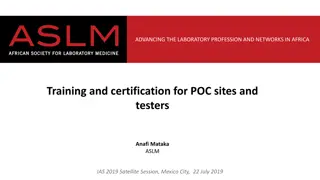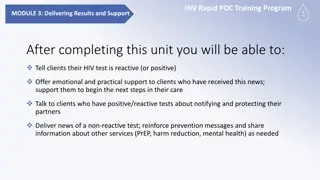HIV Rapid POC Training Program - Assessing HIV Risk
This HIV Rapid POC Training Program module focuses on assessing HIV risk by understanding the balance of partners, practices, and protections. It covers topics such as introducing the testing conversation, assessing risk and client service needs, explaining the test and obtaining consent, performing the test, and providing follow-up support. Learn about high-risk exposures, when to recommend testing, and adapting counseling to individual needs following Ontario guidelines.
Download Presentation

Please find below an Image/Link to download the presentation.
The content on the website is provided AS IS for your information and personal use only. It may not be sold, licensed, or shared on other websites without obtaining consent from the author. Download presentation by click this link. If you encounter any issues during the download, it is possible that the publisher has removed the file from their server.
E N D
Presentation Transcript
HIV Rapid POC Training Program MODULE: Assessing HIV Risk After completing this unit you will be able to : Understand the balance of partners, practices and protections, when assessing HIV risk Ask clients about their reasons for testing and their risk behaviours in a respectful way Adapt counselling to the needs of the individual testing Outline Ontario s guidelines about appropriate frequency of HIV testing
HIV Rapid POC Training Program MODULE: Assessing HIV Risk This module focuses on the second stage of testing: 1) Introducing the testing conversation 2) Assessing risk and the client s service needs 3) Explaining the test and obtaining consent 4) Performing the test 5) Providing follow-up support around the test results and referral to services As for all testing discussions, your approach should beARCCH Adapted to client needs, Respectful and non-judgemental, Confidential, Consenting and part of linking the client to a continuum of High-quality services
HIV Rapid POC Training Program MODULE: Reasons and Risk MODULE: Assessing HIV Risk When should a person be tested for HIV? A person should be tested for HIV whenever they have had one or more high-risk exposure(s) to HIV. There are three elements to weigh when determining the degree of HIV risk a client has encountered: partners, practices and protections Not every high-risk exposure will result in HIV infection, but testing should be recommended after any high-risk exposure.
HIV Rapid POC Training Program MODULE 2: Assessing HIV Risk Assessing Risk Partners Assessing risk means working with clients to understand the balance of the three Ps: partners, practices and protections. Practices Protections
HIV Rapid POC Training Program MODULE 2: Assessing HIV Risk What is a high-risk exposure? For an exposure to be high risk, all three of the following conditions must be true: Partners: The client s sexual partners are HIV-positive (or may be HIV positive), and may have detectable levels of HIV; sharing of needles and other equipment should always be considered a risk of the drug-use partner(s) may be HIV-positive Practices: The client and their partner(s) were involved in practices that exchanged blood, semen, rectal fluid, vaginal fluid or breast milk Protections: There may have been gaps in the prevention strategies the client used for protection from HIV infection There is no HIV risk, if an exposure does not involve partners, practices and gaps in protection that can put the client at risk.
HIV Rapid POC Training Program MODULE 2: Assessing HIV Risk Partners Often clients cannot be sure of the HIV status of their partner(s). However, we know that the people living with HIV in Ontario, are almost all part of one of these five population groups. The percentage of new diagnoses from each of these groups is shown (2017): gay, bisexual and other men who have sex with men, including trans men (54%) African, Caribbean and Black (ACB) communities including men and women from regions where HIV is endemic (29%) Indigenous peoples (3%) people (men and women) who inject drugs or share drug equipment (10%) women* = cis and trans women, including women from the above populations, and other women who face systemic and social inequities, and are more likely to be exposed to HIV through a sexual or drug using partner (21%) These groups are the focus of Ontario s HIV prevention and testing programs and are referred to as priority populations. It adds up to more than 100%, because some people are identified as part of more than one group.
HIV Rapid POC Training Program MODULE 2: Assessing HIV Risk *Only five body fluids can contain enough HIV to pass the infection: blood, semen (including pre-cum), rectal fluid, vaginal fluid and breast milk Partners To pass HIV to another person, someone must: Be infected with HIV (be HIV-positive) Have a high enough concentration of HIV in their body fluids* to infect someone else Treatment Both time and treatment affect the amount of HIV in the body of an HIV-positive person; but without treatment transmission is always possible Amount of HIV Becomes Undetectable Time Even with the consistent use of an effective antiretroviral drug, the time to reach undetectable varies (typically 2-5 months.) The best outcomes are reported for people who begin treatment within a few days of their diagnosis, making linkage to care a vital part of the testing process.
HIV Rapid POC Training Program MODULE 2: Assessing HIV Risk Partners What does undetectable/detectable mean? U=U Undetectable = Untransmittable Undetectable means that HIV treatment has reduced the amount of HIV in a person s blood below the level that a viral load test can measure. The person is not cured, but if they continue treatment, HIV will cause little harm to their body. Someone can not pass HIV to another person sexually if they have been undetectable for six months. The transmission risk of needle sharing is also reduced. The U=U slogan celebrates the fact that effective HIV treatment makes it impossible for an undetectable person to infect anyone else through sex Detectablemeans that the number of copies of HIV in a person s blood can be count with a viral load test. When HIV can be detected, HIV is replicating in a person s system and that their health may be at risk. HIV-positive people who consistently take antiviral treatments are protecting their own health AND others.
HIV Rapid POC Training Program MODULE 2: Assessing HIV Risk Partners HIV Status and Serosorting Serosorting means choosing ones sexual partners based on their HIV status (negative or undetectable) The Challenge of Being Sure If a potential partner tells you that they are HIV-negative or undetectable is that enough? People often assume they know their HIV status but haven t been tested recently. Others may not fully understand the terms they use. We all want to trust each other but if a client cannot be sure that there is no risk, advise them to test. Serosorting is based on facts: An HIV-negative person cannot transmit HIV An HIV-positive person who is undetectable cannot transmit HIV however, particularly with casual partners, it also raises challenging questions of trust and truthfulness. The basic rule for counselling: If the client can t be sure, recommend testing!
HIV Rapid POC Training Program MODULE 2: Assessing HIV Risk Partners In Summary: Partners Practices An HIV exposure may be high-risk if: A client s partner(s) are HIV positive, and the client can not be sure that their viral load is undetectable Protections The client and/or their sexual partners are members of one of Ontario s priority populations and the client has one or more partners whose HIV status they don t know Remember: assessing risk is a balance. The status of a client s partners only matters if they are engaged in high risk practices or there are gaps in their protections.
HIV Rapid POC Training Program MODULE 2: Assessing HIV Risk Practices Whether or not a person has had a high risk exposure also depends on their practices. There is never any risk in touching, hugging, sharing food or mutual masturbation with an HIV-positive person, regardless of the amount of virus in their body. The following activities are high risk, if a person s partner(s) were HIV positive with a detectable viral load and no precautions were taken to avoid sharing body fluids: Anal sex - both receptive and insertive sex Vaginal sex - both receptive and insertive sex Sharing needles, or other equipment to inject or inhale drugs Sharing sex toys inserted into both bodies without washing in between and no condom use
HIV Rapid POC Training Program MODULE 2: Assessing HIV Risk Practices All high risk practices are not equal, here are some estimates of the risk associated with each act with a detectable HIV-positive partner: These risks are often lower than people expect, however even a single one of these acts will sometimes result in an HIV infection Act Likely Rate of Transmission per Act Receptive Anal Sex (someone penetrated the client) 1 transmission / 71 acts Injecting drugs with a shared needle 1 transmission / 159 acts Insertive Anal Sex (the client penetrated someone else) 1 transmission / 909 acts Receptive Vaginal Sex (someone penetrated the client) 1 transmission / 1250 acts Insertive Vaginal Sex (the client penetrated someone else) 1 transmission / 2500 acts Check your participant s handout for detailed resources about the relative risk of different activities including the source of this table!
HIV Rapid POC Training Program MODULE 2: Assessing HIV Risk Practices Partners Practices In summary: Focus on how the person has sex when discussing practices Protections Only activities that exchanged blood, semen, rectal fluid, vaginal fluid or breast milk can transmit HIV Remember: High risk practices, such as anal sex, can only be high- risk exposures, if a client s partner is potentially HIV-positive and detectable, and if there are potentially gaps in the client s prevention strategies.
HIV Rapid POC Training Program MODULE 2: Assessing HIV Risk Protections HIV infection can be prevented by avoiding contact with the blood, semen (including pre- cum), rectal fluid, vaginal fluid and breast milk of anyone who might be infected. Protective Strategies: Abstinence/Low Risk Sex avoiding activities that exchange these fluids by only engaging in no-risk or low-risk activities such as oral sex or mutual masturbation Harm Reduction using clean disposable products to inject or inhale drugs: to avoid HIV infection needles, cookers, water and filters, as well as pipes and stems, must not be shared Condoms using condoms every time there is penetrative sex PrEP (Pre-Exposure Prophylaxis) taking antiviral drugs regularly to prevent infection
HIV Rapid POC Training Program MODULE 2: Assessing HIV Risk Gaps in Protection Possible Strategies: Abstinence/Low Risk Sex Harm Reduction Condoms PrEP (Pre-Exposure Prophylaxis) Each of these strategies work! When talking with clients it is important that you acknowledge the positive things clients may be doing to protect their health. However sometimes gaps occur. Help clients think about gaps when assessing risk. Has a client ever had a condom slip off or had a partner stealth* them? Did they ever wait to put the condom on? Do they ever miss one of their PrEP pills? Might they have forgotten about sharing a needle when they were high? * Stealthing = a partner covertly removed the condom, when only condom-protected sex has been agreed to.
HIV Rapid POC Training Program MODULE 2: Assessing HIV Risk Protections In summary: Partners Practices People can protect themselves against HIV infection: condoms, PrEP and limiting their sexual practices to low-risk exposures work, as does harm reduction around drug use Protections Remember: A broken condom or other protection gap can only lead to a high-risk exposure whena client s partner is potentially HIV-positive and detectable, and when their practices together may expose your client to blood, semen, rectal fluid, vaginal fluid or breast milk. . however gaps can occur in any of these prevention strategies. Some gaps to ask about are included in your handout.
HIV Rapid POC Training Program MODULE 2: Assessing HIV Risk Conversations about Risk General Approach Follow the client s lead. Start with why they came for HIV testing. Try mirroring the client s language. Be aware of the words that they are comfortable using to describe their sexual activities and relationships; try to use similar language. Ask questions and present information in a relaxed, non-judgmental way, which suggests that others can and do disclose to you (e.g. Other guys have told me..) Keep your language as simple as possible. Be supportive of client s strategies for reducing their risks, even when suggesting additional precautions. Don t make assumptions; people can have more than one risk factor!
HIV Rapid POC Training Program MODULE 2: Assessing HIV Risk Intake Forms Many clinics have an intake form for people coming forward for HIV and other testing (a model intake form is available for download on the HIV Testing site, if needed) An intake form can provide some information for you to get started on your conversation, help you identify members of priority populations and learn about a client s past/current use of services (testing/PrEP/PEP) Some intake forms have checkboxes to help you record what you talk about An intake form can also help you complete some of the basic demographic information required by the laboratory requisition forms Get familiar with the intake form used at your site
HIV Rapid POC Training Program MODULE 2: Assessing HIV Risk Starting the Conversation Possible Questions The Starting Point Thanks for coming in. What made you come in today? Did something happen that worries you? The checklist (included in your last handout) suggests questions around partners, practices and protections and how to go more in-depth around issues like: HIV-positive partners Sexual risks Drug use Role-playing possible conversations and shadowing your colleagues are the best ways to learn. Condom Use and PrEP Window period testing Look in your handout for some frequently used phrases! The checklist is a resource to help you cover all the material, but counselling is a conversation. Let the client s needs guide the flow of your conversation.
HIV Rapid POC Training Program MODULE 2: Assessing HIV Risk Risk and Violence Violence and abuse can make it more difficult for a person to reduce their risks and may be revealed during the course of your risk assessment. Learn about and practice trauma aware care. Any client could have a history of trauma. Remember: exposure to HIV may have occurred in the context of trauma. For example, someone sexually assaulted in a conflict zone, may not view this as sex, and may not be able/willing to talk about the details of the exposure. If a client reveals abuse or violence acknowledge how difficult this experience must have been, and your support (I m sorry that happened to you). Offer resources. Know the services in your area, and offer to connect clients to support around leaving an abusive partner or dealing with an assault. Whenever possible, help the client make contact with needed resources. Offer to call the recommended service provider and set up an appointment.
HIV Rapid POC Training Program MODULE 2: Assessing HIV Risk Testing after a Sexual Assault HIV testing is appropriate. Don t press a client to reveal specific risks, but if they wish to, you may be able to help reassure them about the relative risks (e.g. If he didn t penetrate you the risks of HIV infection are low.) If you are seeing the client within 72 hours of an assault, suggest the option of post- exposure prophylaxis (PEP) and refer to this service if requested. PEP is provided without cost to sexual assault survivors. Plan B to prevent pregnancy can also be suggested. Connect the client to additional resources including sexual assault services, mental health supports, STI screening or pregnancy testing, if appropriate.
HIV Rapid POC Training Program MODULE 2: Assessing HIV Risk Risk and Drug Use Some drug use is illegal/stigmatized; focus on transmission risk. Acknowledge that many clients protect themselves, while continuing to use illegal drugs (e.g. It is great that you regularly exchange supplies at [your local needle exchange].) Ask about needle use with any drugs, regardless of their legal status (steroids/hormones); use the Ontario Harm Reduction Distribution Program website to help people find clean needles locally. Ask about sharing of cookers, filters, water as well as needles and about sharing pipes/stems for inhalation; sharing any of these items is a high-risk exposure. Offer information about useful harm reduction and social services; ask if they need support around problem drug use and refer to addictions services, if requested. Remember: Some drug use, particularly stimulants like crystal methamphetamine, can also promote sexual risk taking (i.e. risks may be intertwined; ask about both)
HIV Rapid POC Training Program MODULE 2: Assessing HIV Risk Service Referrals Continuum of Care Talking about risk helps you make recommendations for testing, but it also presents opportunities to connect clients to a continuum other services, including both sexual health services and social services. For example: Sexual Health: Post-exposure prophylaxis (PEP) for a recent exposure (last 72 hours) HIV risk reduction programs for specific populations (often offered by AIDS Service Organizations ) Pre-Exposure Prophylaxis (PrEP) for people taking ongoing risks Screening for other sexually transmitted infections (STI), if not offered at your site. For example: Recommend syphilis testing for men who have sex with men Recommend hepatitis C testing for people who use drugs Referrals aren t just for HIV- positive clients; at-risk clients need your help too!
HIV Rapid POC Training Program MODULE 2: Assessing HIV Risk Service Referrals Examples: Social Services, Addictions and Harm Reduction: Services to help clients deal with abuse and sexual assault Harm reduction services for people using drugs not just needles! Addiction services for those dissatisfied with their drug use; Mental health services if clients disclose struggles; Social services to deal with housing or other challenges, as well as sources of additional medical care, if needed. Harm reduction can also include Party n Play kits for those using meth or education around safer drug use. Know the services in your area. When possible, help clients find what they need!
HIV Rapid POC Training Program MODULE 2: Assessing HIV Risk Testing Recommendations Encourage testing for clients who ve had a high-risk exposure since their last test For follow-up of a recent exposure recommend clients return for testing at 3 weeks, six weeks and three months (3-6-3 testing); the scientific basis for this schedule is addressed in a future unit. For exposures in the past 3-4 weeks, advise standard testing (sent to the public health laboratories) in conjunction with rapid testing Date of possible exposure 3 weeks Include standard lab test 6 weeks 3 months If a client has had only protected exposures,or only participated in low risk practices (i.e. oral sex) advise them that their risk is low. Test, however there is no need for follow-up 3-6-3 testing.
HIV Rapid POC Training Program MODULE 2: Assessing HIV Risk Testing Recommendations If a client is routinely returning for testing without any significant risk: Tell them they are not at risk, but don t repeat endlessly Acknowledge their feelings, listen to their perceptions Talk about what is making them feel anxious, and refer them to additional counselling as possible Counselling guidelines are available for high anxiety clients, check your handout for where to find them if needed. Use your judgement about performing the test. It is OK to do a test if desired, but to avoid fueling a cycle of anxiety, it may some- times be appropriate not to do requested testing for these clients.
HIV Rapid POC Training Program MODULE 2: Assessing HIV Risk Ongoing Testing Clients from priority populations who had any risk exposures (even ones where protections were used) should be advised to return for testing annually; Clients should be advised to test on the 3-6-3 schedule after any high-risk exposure; however if such exposures are happening too frequently to make this feasible for them, suggest testing as often as possible, at least every 3 months; encourage consideration of PrEP. Clients with no risk exposures do not require routine testing unless their risk behaviours change.
HIV Rapid POC Training Program MODULE 2: Assessing HIV Risk Express Testing Clients who test routinely know their risks and understand the testing process; for these clients, some sites offer express testing services In an express appointment, discussions of risk and of the test process may be minimal Consent is still necessary from these clients; as well as confirmation that they have considered who will support them in the event of a positive test Express options are also becoming an option for sexually transmitted infection (STI) testing. For example, Toronto Public Health offers Easy Screen STI testing for some clients without symptoms.
HIV Rapid POC Training Program MODULE 2: Assessing HIV Risk Summary: Pre-test Counselling ARCCH The first three stages of testing are often referred to as pre-test counselling. In Ontario s testing program these steps must be 1) Introducing the testing conversation Be welcoming and non-judgmental, take direction from the client s needs 2) Assessing risk and considering service needs Ask risk questions in a non-stigmatizing, conversational way; identify opportunities for needed service referrals Key information for each of these stages is indicated on the checklist 3) Explaining the test and obtaining consent Verbally confirm consent; ensure the client understands the consequences of testing and has considered the possibility of a positive test; get them to think of someone in their life that would support them
